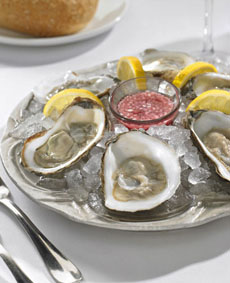

Oysters on the half shell. Photo courtesy Del Frisco restaurant.
July 2007
Last Updated February 2013
|
 |
Oyster Type
Oyster Glossary Page 5: Oyster Types Beginning With
D To I
CAPSULE REPORT: This is page five of a nine-page article about the oyster. Here, oyster types beginning with D to I. Click on the black links below to visit other pages. Also visit our more than 50 food glossaries that focus on other favorite foods, including a 13-page Seafood Glossary.
DENMAN ISLAND OYSTER
Denman Island is located near Fanny Bay on the east coast of Vancouver Island, British Columbia, although they it has its own unique micro environment that produces a watermelon finish to the oyster, instead of Fanny Bays’ cucumber finish. The Denman Island oyster is beach grown and has a thick, hard shell, plus the island’s characteristic cold-water saltiness and sweet meat. It is available from October to July.
EASTERN or EAST COAST OYSTER
See Virginica oyster.
ELKHORN OYSTER
A Pacific oyster harvested from farmed beds in Willapa Bay, the Elkhorn offers firm, crisp, briny, crunchy meat that finishes with a clean, melon-like flavor. It is brought to market at 3- to 3-1/2 inches in size. (See our review of Willapa Oysters, a NIBBLE Top Pick Of The Week.)
EUROPEAN OYSTER or EUROPEAN FLAT OYSTER
See flat oyster, Ostrea edulis.
FANNY BAY OYSTER
A variety of Pacific oyster that is cultured on the beaches of Baynes Sound, near the small town of Fanny Bay, on the east coast of Vancouver Island, British Columbia. The plump, firm flesh is sweet with a cucumber finish; the water is very cold, yielding substantial saltiness and an aftertaste similar to cucumber. Fanny Bays are also popular because the shells are thick and easy to open. They are available from September to July.
FINISH
The aftertaste, or the last flavor left on the palate after the oyster has been consumed.
FLAT OYSTER or EUROPEAN FLAT OYSTER or BELON OYSTER
The flat oyster, Ostrea edulis, is a species of oyster of which the Belon, from the French river of the same name, is the most well-known. Also called the European oyster. Other flat oysters include the Colchester, Dorset, Galway, Helford, Marennes and Whitstable. The roundish oyster has a comparatively flat, smooth shell, compared to the oval, rougher, ribbed shell of the Pacific oyster. It is easily distinguished by a larger, saucer-like shape and seaweed green color. Centuries of over-harvesting reduced the numbers of native oysters in Europe drastically by the 1850s; in the 1970s, two oyster diseases took out most of the remaining stock. Today in the U.S. the flat oyster is grown by a few farmers in the U.S. and Canada; it also grows wild in the Damaricsotta River in Maine. It has a large, plump texture with a strong, gamey flavor and coppery, metallic notes. Look for them October through February. |
|

The European, flat or Belon oyster. These were harvested wild from the Damaricsotta River in Maine. Photo courtesy Waterbar | San Francisco. |
GOLDEN MANTLE OYSTER
So-called because of the slightly golden appearance to its shell, the golden mantle oyster is farmed in the mountain-fed waters near Vancouver, British Colombia. The oyster, about 3 inches in length, has a deep cup, plump, sweet meat, crisp flavor and a melon-like finish.
HAMA HAMA OYSTER
A variety of Pacific Oyster grown on the delta of the Hama Hama River on the Olympic Peninsula in western Washington State. The Hama Hama oyster is known for its excellent, briny flavor, firm meat and mild finish. The river has a fast run from the mountains to the sound, so its waters stay cold year round. Because the river water is so cold, the oyster meat stays firm well into the summer months.
IMPERIAL EAGLE OYSTER
This beach-cultured Pacific oyster is from the west side of Vancouver Island (Fanny Bays are from the east side of the island). The imperial eagle oyster is grown in ideal conditions, far from any industrial or population centers. The channel is open to the cold North Pacific waters, rich in nutrients that make the flesh plump and sweet, with a watermelon-rind finish. One of the saltier west coast oysters, the briny flavor compliments the fruity finish. The oyster is 3 to 3 ½ inches in size and is available from September to July.
ISLAND CREEK OYSTER
A variety of Virginica oyster from Massachusetts. A briny oyster with a clean aftertaste, it is harvested in a creek in Duxbury Bay, is a smaller bay within Cape Cod Bay in Massachusetts.
Continue To Page 6: Types Of Oysters Beginning With J To N
Go To The Article Index Above

|





